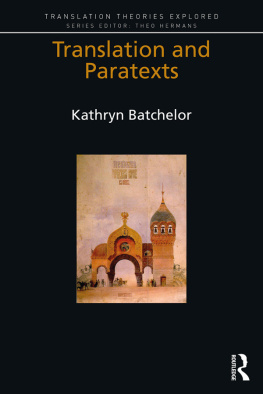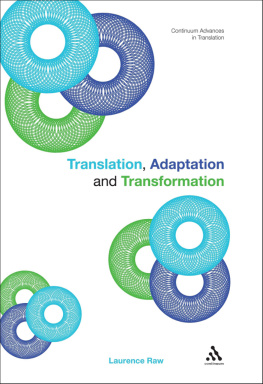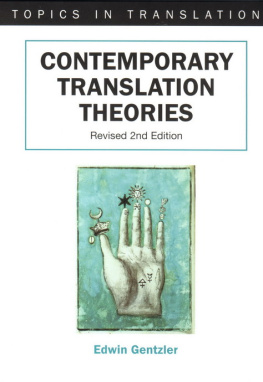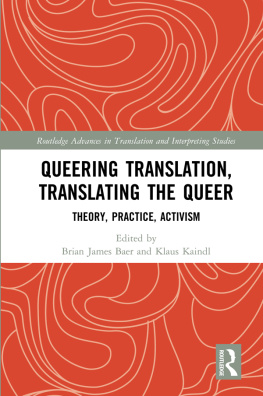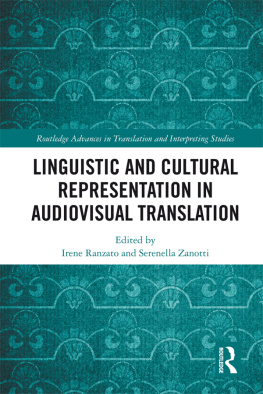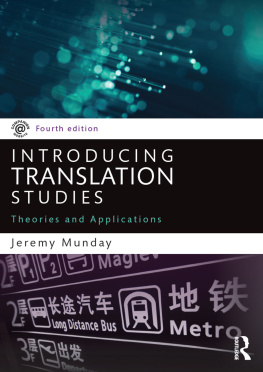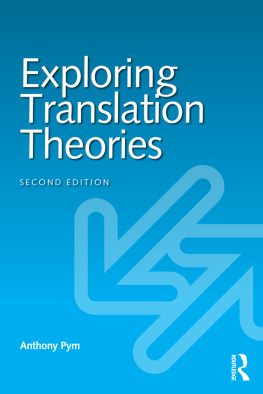
p.i
TRANSLATION AND PARATEXTS
As the thresholds through which readers and viewers access texts, paratexts have already sparked important scholarship in literary theory, digital studies and media studies. Translation and Paratexts explores the relevance of paratexts for translation studies and provides a framework for further research.
Writing in three parts, Kathryn Batchelor first offers a critical overview of recent scholarship, and in the second part introduces three original case studies to demonstrate the importance of paratextual theory. Batchelor interrogates English versions of Nietzsche, Chinese editions of Western translation theory, and examples of subtitled drama in the UK, before concluding with a final part outlining a theory of paratextuality for translation research, addressing questions of terminology and methodology.
Translation and Paratexts is essential reading for students and researchers in translation studies, interpreting studies and literary translation.
Kathryn Batchelor is Associate Professor of Translation and Francophone Studies at the University of Nottingham, UK. She is the author of Decolonizing Translation (Routledge, 2009) and has co-edited four volumes of essays, including Translating Frantz Fanon Across Continents and Languages (Routledge, 2017) and Intimate Enemies: Translation in Francophone Contexts (Liverpool University Press, 2013).
p.ii
Translation Theories Explored
Series Editor: Theo Hermans, UCL, UK
Translation Theories Explored is a series designed to engage with the range and diversity of contemporary translation studies. Translation itself is as vital and as charged as ever. If anything, it has become more plural, more varied and more complex in todays world. The study of translation has responded to these challenges with vigour. In recent decades the field has gained in depth, its scope continues to expand and it is increasingly interacting with other disciplines. The series sets out to reflect and foster these developments. It aims to keep track of theoretical developments, to explore new areas, approaches and issues, and generally to extend and enrich the intellectual horizon of translation studies. Special attention is paid to innovative ideas that may not as yet be widely known but deserve wider currency.
Individual volumes explain and assess particular approaches. Each volume combines an overview of the relevant approach with case studies and critical reflection, placing its subject in a broad intellectual and historical context, illustrating the key ideas with examples, summarising the main debates, accounting for specific methodologies, achievements and blind spots, and opening up new avenues for the future. Authors are selected not only on their close familiarity and personal affinity with a particular approach but also on their capacity for lucid exposition, critical assessment and imaginative thought. The series is aimed at researchers and graduate students who wish to learn about new approaches to translation in a comprehensive but accessible way.
Stylistic Approaches to Translation
Jean Boase Beier
Representing Others
Kate Sturge
Cosmopolitanism and Translation
Esperana Bielsa
Translating as a Purposeful Activity 2e
Christiane Nord
For more information about this series, please visit www.routledge.com/Translation-Theories-Explored/book-series/TTE
p.iii
TRANSLATION AND
PARATEXTS
Kathryn Batchelor

p.iv
First published 2018
by Routledge
2 Park Square, Milton Park, Abingdon, Oxon OX14 4RN
and by Routledge
711 Third Avenue, New York, NY 10017
Routledge is an imprint of the Taylor & Francis Group, an informa business
2018 Kathryn Batchelor
The right of Kathryn Batchelor to be identified as author of this work has been asserted by her in accordance with sections 77 and 78 of the Copyright, Designs and Patents Act 1988.
All rights reserved. No part of this book may be reprinted or reproduced or utilised in any form or by any electronic, mechanical, or other means, now known or hereafter invented, including photocopying and recording, or in any information storage or retrieval system, without permission in writing from the publishers.
Trademark notice : Product or corporate names may be trademarks or registered trademarks, and are used only for identification and explanation without intent to infringe.
British Library Cataloguing-in-Publication Data
A catalogue record for this book is available from the British Library
Library of Congress Cataloging-in-Publication Data
Names: Batchelor, Kathryn, author.
Title: Translation and paratexts / Kathryn Batchelor.
Description: London : Routledge, [2018] | Series: Translation theories explored | Includes bibliographical references and index.
Identifiers: LCCN 2018001333 (print) | LCCN 2018020791 (ebook) | ISBN 9781351110112 (Master) | ISBN 9780815349228 (hardcover : alk. paper) | ISBN 9781138488977 (softcover : alk. paper) | ISBN 9781351110112 (ebook)
Subjects: LCSH: Paratext. | Translating and interpreting.
Classification: LCC Z242.P37 (ebook) | LCC Z242.P37 B38 2018 (print) | DDC 418/.02dc23
LC record available at https://lccn.loc.gov/2018001333
ISBN: 978-0-8153-4922-8 (hbk)
ISBN: 978-1-138-48897-7 (pbk)
ISBN: 978-1-351-11011-2 (ebk)
Typeset in Bembo Std
by Swales & Willis Ltd, Exeter, Devon, UK
p.v
For Jon, Samuel and Alex
p.ix
p.x
In practical terms, this book could not have been written without the research leave semester granted by the School of Cultures, Languages and Area Studies, University of Nottingham, and the additional leave semester awarded through the PVCs Fund, Faculty of Arts, University of Nottingham. I am privileged to work for an institution that has the means to grant dedicated research time in this way, and am particularly grateful to colleagues who took on extra tasks in my absence.
On an intellectual level, I would like to thank Theo Hermans, Dorota Gouch, and students at the Translation Research Summer School in 2013, where my interest in paratexts first evolved into a plan for a book. I am also grateful to Theo and the editors at Routledge for allowing me to extend the deadline several times in light of other projects and work pressures. Having a year off to work on this book has allowed me to catch up with what has been happening in translation studies, beyond my own immediate research interests. I have been reminded time and again of the richness of our discipline, and of the collegiality of the international translation studies community.
In terms more specifically of content, I would like to thank Sarah Fang Tang for her considerable help with .
p.xi
On a personal level, I am extremely grateful for my family, who give me the kind of contentment that makes writing a book a relatively easy task. Having Michael Jackson on a loop in the background certainly added to the experience. Finally, it would not do to forget Charlie the cat, a most excellent research leave companion, despite his fondness for sitting on computers. If any typos remain, they can no doubt be attributed to him.
p.1
Paratextuality... is first and foremost a treasure trove of questions without answers.
Grard Genette, Palimpsests (1997a, 4)
A few months ago, I had the privilege of hearing the Hall Orchestra perform Mussorgskys Pictures at an Exhibition . Before lifting the baton, the conductor told the audience about Mussorgskys close friendship with Viktor Hartmann, an architect and artist. Mussorgsky and Hartmann were roughly the same age, and both were struggling to achieve success in their careers. When Hartmann died, aged 39, his friends organised a posthumous exhibition of his work, and it was this that Mussorgsky turned into music, writing the piece as a memorial to Hartmann. The conductor explained that the works on display at the exhibition were not as we might imagine: most of them were small simple sketches or drawings rather than the more significant kinds of art works that knowing Mussorgskys lengthy and masterful music most listeners assume. With this at the front of my mind, I heard the final movement in a completely new way: the majestic return of the promenade theme was no longer simply Mussorgsky striding through the exhibition, but an exhilarating celebration of his friends life, however unsuccessful a life in other peoples eyes; and the carillon bell of the Great Gate of Kiev that sounds alongside the promenade became the bell tolling Hartmanns death. The meaning of the movement, in other words, changed for me: it became about celebrating life in grief, and by extension about living life alongside the knowledge of our own deaths a memento mori of sorts . How valid this interpretation of Mussorgskys piece might be is not the point that I want to explore here; rather, I want simply to show that the threshold through which I entered the piece the conductors introduction influenced how I interpreted it.
Next page
